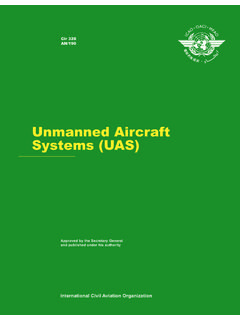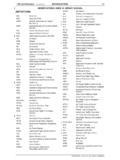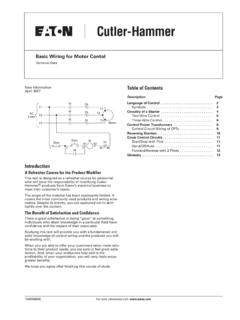Transcription of Selected Aviation Terms and Their Meanings -A-
1 Selected Aviation Terms and Their Meanings -A- ABEAM: An aircraft is abeam a fix, point, or object when that fix, point, or object is approximately 90 degrees to the right or left of the aircraft track. Abeam indicates a general position rather than a precise point. ADIZ (Air Defense Identification Zone): The area of airspace over land or water, extending upward from the surface, within which the ready identification, the location, and the control of aircraft are required in the interest of national security. a. Domestic Air Defense Identification Zone. An ADIZ within the along an international boundary of the b. Coastal Air Defense Identification Zone. An ADIZ over the coastal waters of the c. Distant Early Warning Identification Zone (DEWIZ.) An ADIZ over the coastal waters of the State of Alaska. AERONAUTICAL CHART: A map used in air navigation containing all or part of the following: topographic features, hazards and obstructions, navigation aids, navigation routes, designated airspace, and airports.
2 Commonly used aeronautical charts are: a. Sectional Aeronautical Charts (1:500,000) Designed for visual navigation of slow or medium speed aircraft. b. VFR Terminal Area Charts (1:250,000) Depict Class B airspace which provides for the control or segregation of all the aircraft within Class B airspace. c. World Aeronautical Charts (WAC) (1:1,000,000) Provide a standard series of aeronautical charts covering land areas of the world at a size and scale convenient for navigation by moderate speed aircraft. d. En Route Low Altitude Charts Provide aeronautical information for en route instrument navigation (IFR) in the low altitude stratum. e. En Route High Altitude Charts Provide aeronautical information for en route instrument navigation (IFR) in the high altitude stratum. f. Instrument Approach Procedures (IAP) Charts - Portray the aeronautical data which is required to execute an instrument approach to an airport.
3 G. Instrument Departure Procedure (DP) Charts Designed to expedite clearance delivery and to facilitate transition between takeoff and en route operations. h. Standard Terminal Arrival (STAR) Charts Designed to expedite air traffic control arrival procedures and to facilitate transition between en route and instrument approach operations. i. Airport Taxi Charts Designed to expedite the efficient and safe flow of ground traffic at an airport. A/FD (Airport/Facility Directory): A publication designed primarily as a pilot's operational manual containing all airports, seaplane bases, and heliports open to the public including communications data, navigational facilities, and certain special notices and procedures. This publication is issued in seven volumes according to geographical area. AIRCRAFT APPROACH CATEGORY: A grouping of aircraft based on a speed of times the staff speed in the landing configuration maximum gross landing weight.
4 An aircraft shall fit in only one category. If it is necessary to maneuver at speeds in excess of the upper limit of a speed range for a category, the minimums for the next higher category should be used. For example, an aircraft which falls in Category A, but is circling to land at a speed in excess of 91 knots, 1 of 22. should use the approach Category B minimums when circling to land. The categories are as follows: a. Category A Speed less than 91 knots. b. Category B Speed 91 knots or more but less than 121 knots. c. Category C Speed 121 knots or more but less than 141 knots. d. Category D Speed 141 knots or more but less than 166 knots. e. Category E Speed 166 knots or more. AIRCRAFT CLASSES: For the purposes of Wake Turbulence Separation Minima, ATC. classifies aircraft as Heavy, Large, and Small as follows: a. Heavy Aircraft capable of takeoff weights of more than 255,000 pounds whether or not they are operation at this weight during a particular phase of flight.
5 B. Large Aircraft of more than 41,000 pounds, maximum certificated takeoff weight, up to 255,000 pounds. c. Small Aircraft of 41,000 pounds or less maximum certificated takeoff weight. AIR NAVIGATION FACILITY: Any facility used in, available for use in, or designed for use in, aid of air navigation, including landing areas, lights, any apparatus or equipment for disseminating weather information, for signaling, for radio-directional finding, or for radio or other electrical communication, and any other structure or mechanism having a similar purpose for guiding or controlling flight in the air or the landing and take-off of aircraft. AIRPLANE DESIGN GROUP: A grouping of airplanes based on wingspan. The groups are as follows: a. Group I: Up to but not including 49-feet b. Group II: Greater than 49-feet but less than 79-feet. c. Group III: Greater than 79-feet but less than 118-feet d.
6 Group IV: Greater than 118-feet but less than 171-feet e. Group V: Greater than 171-feet but less than 214-feet f. Group VI: Greater than 214-feet but less than 262-feet AIRPORT ADVISORY AREA: The area within ten miles of an airport without a control tower or where the tower is not in operation, and on which a Flight Service Station is located. AIRPORT ELEVATION: The highest point of an airport's usable runways measured in feet from mean sea level. AIRPORT IMPROVEMENT PROGRAM: A federal grant program used to fund airport development on a priority rated system. In order for an airport to receive AIP funding, the airport must have an approved ALP and be included in the NPIAS. AIRPORT LAYOUT PLAN: The plan of an airport showing the layout of existing and proposed airport facilities. AIRPORT MARKING AIDS: Markings used on runway and taxiway surfaces to identify a specific runway, a runway threshold, a centerline, a holdline, etc.
7 A runway should be marked in accordance with its present usage such as: a. Visual. b. Nonprecision instrument. c. Precision instrument. AIRPORT REFERENCE CODE: A coding system for each airport based on the most demanding aircraft. The code is made up of an alpha-numeric designation containing the Aircraft Approach Category and the Airplane Design Group. 2 of 22. AIRPORT REFERENCE POINT (ARP): The approximate geometric center of all usable runway surfaces. AIRPORT ROTATING BEACON: A visual NAVAID operated at many airports. At civil airports, alternating white and green flashes indicate the location of the airport. At military airports, the beacons flash alternately white and green, but are differentiated from civil beacons by dual peaked (two quick) white flashes between the green flashes. AIRSPEED: The speed of an aircraft relative to its surrounding air mass. The unqualified term airspeed means one of the following: a.
8 Indicated Airspeed The speed shown on the aircraft airspeed indicator. This is the speed used in pilot/controller communications under the general term airspeed.. b. True Airspeed The airspeed of an aircraft relative to undisturbed air. Used primarily in flight planning and en route portion of flight. When used in pilot/controller communication, it is referred to as true airspeed and not shortened to airspeed.. AIR TRAFFIC CONTROL: A service operated by appropriate authority to promote the safe, orderly and expeditious flow of air traffic. AIRWAY: A Class E airspace area established in the form of a corridor, the centerline of which is defined by radio navigational aids. ALTIMETER SETTING: The barometric pressure reading used to adjust a pressure altimeter for variations in existing atmospheric pressure or to the standard altimeter setting ( ). ALTITUDE: The height of a level, point, or object measured in feet Above Ground Level (AGL) or from Mean Sea Level (MSL.)
9 APPROACH LIGHTING SYSTEM: An approach lighting system is a series of lights aligned with the runway centerline that extends the runway surface into the approach. An ALS helps the pilot to identify the runway during low visibility and to correctly establish orientation in relation to the runway centerline. APPROACH SPEED: The recommended speed contained in aircraft manuals used by pilots when making an approach to landing. This speed will vary for different segments of an approach as well as for aircraft weight and configuration. APPROACH SURFACE: A surface longitudinally centered on the extended runway centerline and extending outward and upward from each end of the primary surface. An approach surface is applied to each end of the runway based upon the type of approach available or planned for that runway end. The slope of the approach surface can either be 20:1, 34:1 or 50:1, APRON: A defined area on an airport or heliport intended to accommodate aircraft for purposes of loading or unloading passengers or cargo, refueling, parking, or maintenance.
10 With regard to seaplanes, a ramp is used for access to the apron from the water. AREA NAVIGATION: Area Navigation (RNAV) provides enhanced navigational capability to the pilot. RNAV equipment can compute the airplane position, actual track and ground speed and then provide meaningful information relative to a route of flight Selected by the pilot. Typical equipment will provide the pilot with distance, time, bearing and crosstrack error relative to the Selected TO or active waypoint and the Selected route. Several distinctly different navigational systems with different navigational performance characteristics are capable of providing area navigational functions. Present day RNAV includes INS, LORAN, VOR/DME, and GPS systems. AUTOMATED WEATHER OBSERVATION SYSTEM: A system that continuously records, analyzes and disseminates weather information for pilots and air traffic controllers.







